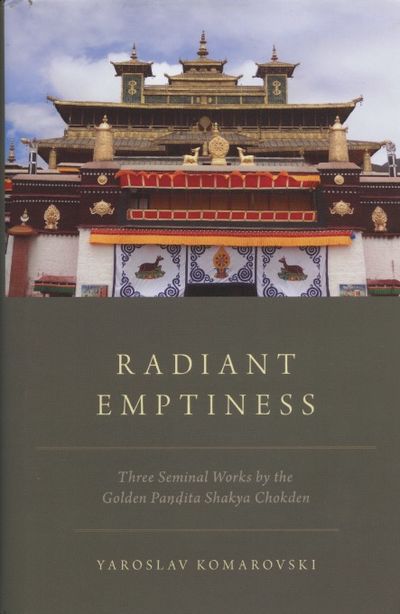Radiant Emptiness
< Books
| (4 intermediate revisions by one other user not shown) | |||
| Line 29: | Line 29: | ||
** {{i| Conclusion upon Generating Respect for the Definitive Meaning of the<br>Third Dharmacakra | 266| 3.3. }} | ** {{i| Conclusion upon Generating Respect for the Definitive Meaning of the<br>Third Dharmacakra | 266| 3.3. }} | ||
*** {{i| Demonstrating the Way That Definitive Meaning Emerged in Valid Treatises | 266| 3.3.1. }} | *** {{i| Demonstrating the Way That Definitive Meaning Emerged in Valid Treatises | 266| 3.3.1. }} | ||
| − | *** {{i| Demonstrating That That Same Definitive Meaning Also Emerges<br>from the Texts of Quintessential Instructions by Indian and Tibetan Scholars | 271| 3.3.2. }} | + | *** {{i| Demonstrating That That Same Definitive Meaning Also Emerges<br>from the Texts of Quintessential Instructions by Indian and Tibetan<br>Scholars | 271| 3.3.2. }} |
*** {{i| Demonstrating the Transmission Sources I Myself Followed | 273| 3.3.3. }} | *** {{i| Demonstrating the Transmission Sources I Myself Followed | 273| 3.3.3. }} | ||
* {{i| Great Path of the Ambrosia of Emptiness: Explanation of Profound Pacification Free from Proliferations | 281| 4. }} | * {{i| Great Path of the Ambrosia of Emptiness: Explanation of Profound Pacification Free from Proliferations | 281| 4. }} | ||
| − | ** {{i| Identification of the Ambrosia That Flowed from the Excellent Words of Our Compassionate Teacher Alone | 282| 4.1. }} | + | ** {{i| Identification of the Ambrosia That Flowed from the Excellent Words of<br>Our Compassionate Teacher Alone | 282| 4.1. }} |
| − | ** {{i| How Each Group of Proponents of the Buddhist Tenets Partakes in Its Share of the Ambrosia | 283| 4.2. }} | + | ** {{i| How Each Group of Proponents of the Buddhist Tenets Partakes in Its<br>Share of the Ambrosia | 283| 4.2. }} |
| − | ** {{i| Systems That Having Understood Emptiness Are Posited as the Pinnacle of Tenet Systems | 286| 4.3. }} | + | ** {{i| Systems That Having Understood Emptiness Are Posited as the Pinnacle<br>of Tenet Systems | 286| 4.3. }} |
*** {{i| Determining the Presentation of Emptiness | 286| 4.3.1. }} | *** {{i| Determining the Presentation of Emptiness | 286| 4.3.1. }} | ||
| − | *** {{i| Explanation of Divisions of the Path Purifying Stains of the Dharma-Sphere | 362| 4.3.2. }} | + | *** {{i| Explanation of Divisions of the Path Purifying Stains of the<br>Dharma-Sphere | 362| 4.3.2. }} |
*** {{i| Entity of Buddhahood Attained by That Path | 387| 4.3.3. }} | *** {{i| Entity of Buddhahood Attained by That Path | 387| 4.3.3. }} | ||
| Line 47: | Line 47: | ||
* {{i| Bibliography| 447 }} | * {{i| Bibliography| 447 }} | ||
* {{i| Index| 459 }} | * {{i| Index| 459 }} | ||
| + | |PublisherLogo=File:Oxford University Press.jpg | ||
| + | |ExtraCategories=Oxford University Press | ||
| + | |StopPersonRedirects=No | ||
|AddRelatedTab=No | |AddRelatedTab=No | ||
| − | |||
}} | }} | ||
Latest revision as of 18:21, 9 November 2021
In Radiant Emptiness, Yaroslav Komarovski offers an annotated translation of three seminal works on the nature and relationship of the Yogacara and Madhyamaka schools of Buddhist thought, by Serdok Penchen Shakya Chokden (1428-1507). There has never been consensus on the meaning of Madhyamaka and Yogacara, and for more than fifteen centuries the question of correct identification and interpretation of these systems has remained unsolved. Chokden proposes to accept Yogacara and Madhyamaka on their own terms as compatible systems, despite their considerable divergences and reciprocal critiques. His major objective is to bring Yogacara back from obscurity, present it in a positive light, and correct its misrepresentation by earlier thinkers. He thus serves as a major resource for scholarly research on the historical and philosophical development of Yogacara and Madhyamaka. Until recently, Shakya Chokden's works have been largely unavailable. Only in 1975 were his collected writings published in twenty-four volumes in Bhutan. Since then, his ingenious works on Buddhist history, philosophy, and logic have attracted increasing scholarly attention. Komarovski's research on Shakya Chokden's innovative writings--most of which are still available only in the original Tibetan--revises early misinterpretations by addressing some of the most complicated aspects of his thought. While focusing on his unique interpretation of Yogacara and Madhyamaka, the book also shows that his thought provides an invaluable base to challenge and expand our understanding of such topics as epistemology, contemplative practice, the relationship between intellectual study and meditative experience, and other key questions that occupy contemporary scholarship on Buddhism and religion in general. (Source: Oxford University Press)
| Citation | Komarovski, Yaroslav. Radiant Emptiness: Three Seminal Works by the Golden Paṇḍita Shakya Chokden. Oxford: Oxford University Press, 2020. |
|---|---|


